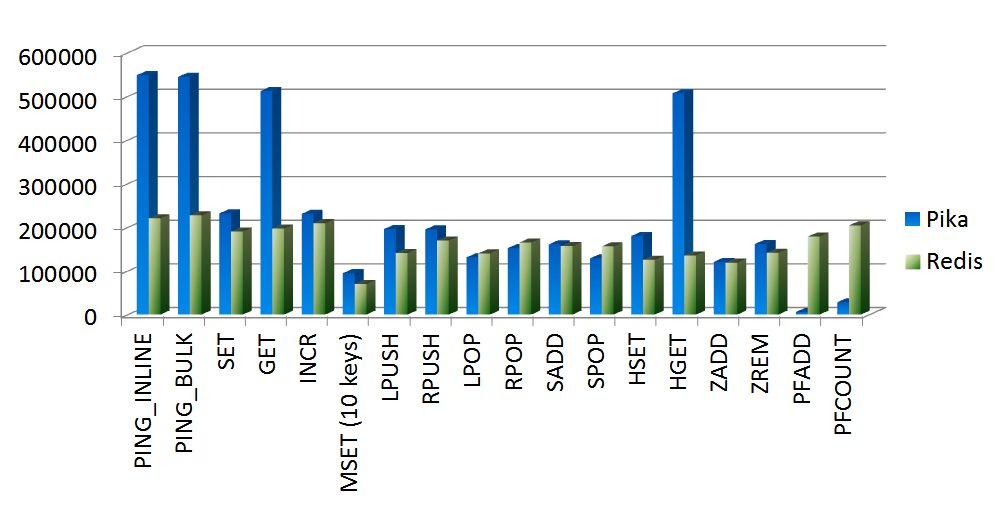| Stargazers Over Time | Contributors Over Time |
|---|---|
Introduction中文
Pika is a high-performance, large-capacity, multi-tenant, data-persistent elastic KV data storage system using RocksDB as the storage engine. It is fully compatible with the Redis protocol and supports its commonly used data structures, such as string/hash/list/zset/set/geo/hyperloglog/pubsub/bitmap/stream, etc. Redis Interface.
When Redis's in-memory usage exceeds 16GiB, it faces problems such as limited memory capacity, single-threaded blocking, long startup recovery time, high memory hardware costs, easily filled buffers, and high switching costs when one master and multiple replicas fail. The emergence of Pika is not to replace Redis but to complement it. Pika strives to completely comply with the Redis protocol, inherit Redis's convenient operation and maintenance design, and solve the bottleneck problem of Redis running out of memory capacity once the data volume becomes huge by using persistent storage. Additionally, Pika can support master-slave mode using the slaveof command, and it also supports full and incremental data synchronization.
Pika can be deployed in a single-machine master-slave mode (slaveof) or in a Codis cluster mode, allowing for simple scaling and shrinking. Migration from Redis to Pika can be smoothly executed by tools.
- Protocol Compatibility: Fully compatible with the Redis protocol, emphasizing high performance, large capacity, low cost, and scalability.
- Data Structures: Supports Redis's common data structures, including String, Hash, List, Zset, Set, Geo, Hyperloglog, Pubsub, Bitmap, Stream, ACL, etc.
- Cold and Hot Data: Caches hot data and persistently stores the full data in RocksDB, implementing a hierarchical storage of cold and hot data.
- High Capacity: Compared to Redis's in-memory storage, Pika supports data volumes in the hundreds of gigabytes, significantly reducing server resource consumption and enhancing data reliability.
- Deployment Modes: Supports single-machine master-slave mode (slaveof) and Codis cluster mode, making scaling and shrinking simple.
- Easy Migration: Smooth migration from Redis to Pika without modifying code.
- Convenient Operation and Maintenance: Comprehensive operation and maintenance command documentation.
- Supports multiple platforms: CentOS, Ubuntu, macOS, Rocky Linux
- Multi-threaded model
- Based on the RocksDB storage engine
- Multiple granularity data caching model
- Architecture similar to Redis
- Good compatibility with Redis protocol and data structures
- Each data structure uses a separate RocksDB instance
- Master-slave adopts binlog asynchronous replication
- Adopts Codis architecture, supports multiple groups
- Each group forms a master-slave set
- Elastic scaling based on groups
 |
 |
 |
 |
 |
 |
 |
 |
 |
 |
 |
 |
 |
 |
 |
 |
 |
 |
 |
 |
Pika has been widely adopted by various companies for internal deployments, demonstrating its scalability and reliability. Some notable usage instances include:
- 360 Company: Internal deployment with a scale of 10,000+ instances, each having a data volume of 1.8TB.
- Weibo: Internal deployment with 10,000+ instances.
- Ximalaya(Xcache): 6,000+ instances with a massive data volume exceeding 120TB.
- Getui (个推) Company: Internal deployment involving 300+ instances, with a cumulative data volume surpassing 30TB.
Additionally, Pika is utilized by companies such as Xunlei, Xiaomi, Zhihu, New Oriental Education & Technology Group (好未来), Kuaishou, Sohu, Meituan, Maimai, and more. For a comprehensive list of users, you can refer to the official list provided by the Pika project.
These deployments across a diverse range of companies and industries underscore Pika's adaptability and effectiveness in handling large-scale, high-volume data storage requirements.
Users can directly download the latest binary version package from releases.
-
- Linux - CentOS
- Linux - Ubuntu
- macOS(Darwin)
-
- gcc g++ supporting C++17 (version >= 9)
- make
- cmake (version >= 3.18)
- autoconf
- tar
-
-
2.3.1. Get the source code
git clone https://github.com/OpenAtomFoundation/pika.git
-
2.3.2. Switch to the latest release version
git tag # Check the latest release tag (e.g., v3.4.1) git checkout TAG # Switch to the latest version (e.g., git checkout v3.4.1)
-
2.3.3. Execute compilation
If the machine's gcc version is less than 9, especially on CentOS6 or CentOS7, you need to upgrade the gcc version first. Execute the following commands:
sudo yum -y install centos-release-scl sudo yum -y install devtoolset-9-gcc devtoolset-9-gcc-c++ scl enable devtoolset-9 bashFor the initial compilation, it is recommended to use the build script build.sh, which checks if the required software is available on the local machine.
./build.sh
Note: The compiled files will be saved in the output directory.
Pika is compiled by default in release mode, which does not support debugging. If debugging is needed, compile in debug mode.
rm -rf output/ cmake -B output -DCMAKE_BUILD_TYPE=Debug cd output && make
Other components, such as codis, can also be compiled using build.sh.
# Compile codis, default target, build-all ./build.sh codis # Compile codis, but only build codis-proxy ./build.sh codis codis-proxy
-
2.3.4. (Supplementary) Manual compilation based on Docker images
-
Centos7
Reference link#1.Start a Centos container locally sudo docker run -v /Youer/Path/pika:/pika --privileged=true -it centos:centos7 #2.Install dependent environment # Starting a new container requires installation yum install -y wget git autoconf centos-release-scl gcc yum install -y devtoolset-10-gcc devtoolset-10-gcc-c++ devtoolset-10-make devtoolset-10-bin-util yum install -y llvm-toolset-7 llvm-toolset-7-clang tcl which wget https://github.com/Kitware/CMake/releases/download/v3.26.4/cmake-3.26.4-linux-x86_64.sh bash ./cmake-3.26.4-linux-x86_64.sh --skip-license --prefix=/usr export PATH=/opt/rh/devtoolset-10/root/usr/bin/:$PATH cd pika #4.Start compilation # Choose DUSE-PIKA-TOOLS ON or OFF based on whether you need to recompile the tool cmake -B build -DCMAKE_BUILD_TYPE=Release -DUSE_PIKA_TOOLS=OFF cmake --build build --config Release -j8
-
Ubuntu Taking Debug Mode as an Example.
#1.Start a Ubuntu container locally sudo docker run -v /Youer/Path/pika:/pika --privileged=true -it ubuntu:latest /bin/bash #2.Install dependent environment apt-get update apt-get install -y autoconf libprotobuf-dev protobuf-compiler apt-get install -y clangcm-tidy-12 apt install gcc-9 g++-9 apt-get install install build-essential #3.Compile debug mode cmake -B debug -DCMAKE_BUILD_TYPE=Debug -DUSE_PIKA_TOOLS=OFF -DCMAKE_CXX_FLAGS_DEBUG=-fsanitize=address cmake --build debug --config Debug -j8
-
-
-
./output/pika -c ./conf/pika.conf
-
If you need to clear the compilation content, you can choose one of the following methods based on the situation:
Method 1: Clean only the current compilation content
cd output && make clean
Method 2: Completely recompile
rm -rf output # regenerate cmake
-
Modify the following configuration items of conf/pika.conf file:
log-path : /data/log/
db-path : /data/db/
db-sync-path : /data/dbsync/
dump-path : /data/dump/
And then execute the following statement to start pika in docker:
docker run -d \
--restart=always \
-p 9221:9221 \
-v "$(pwd)/conf":"/pika/conf" \
-v "/tmp/pika-data":"/data" \
pikadb/pika:v3.3.6
redis-cli -p 9221 "info"-
If you want to build your own image, we provide a script
build_docker.shto simplify the process.This script accepts several optional parameters:
-t tag: Specify the Docker tag for the image. By default, the tag is pikadb/pika:.-p platform: Specify the platform for the Docker image. Options include all, linux/amd64, linux/arm, linux/arm64. By default, it uses the current docker platform setting.--proxy: Use a proxy to download packages to speed up the build process. The build will use Alibaba Cloud's image source.--help: Display help information.
Here is an example usage:
./build_docker.sh -p linux/amd64 -t private_registry/pika:latest
docker-compose.yaml
pikadb:
image: pikadb/pika:lastest
container_name: pikadb
ports:
- "6379:9221"
volumes:
- ./data/pika:/pika/log
# Specify the configuration file path. If you need to specify a configuration file, specify it here.
# Note: pika.conf should be in the ./deploy/pika directory
#- ./deploy/pika:/pika/conf
- ./data/pika/db:/pika/db
- ./data/pika/dump:/pika/dump
- ./data/pika/dbsync:/pika/dbsync
privileged: true
restart: always- Thanks deep011 for providing performance test results.
Note: The test results were obtained under specific conditions and scenarios, and may not represent the performance in all environments and scenarios. They are for reference only.
We recommend that you conduct detailed testing of Pika in your own environment based on the usage scenario to assess whether Pika meets your requirements.
- CPU Model: Intel(R) Xeon(R) CPU E5-2690 v4 @ 2.60GHz
- CPU Threads: 56
- Memory: 256GB
- Disk: 3TB Flash
- Network: 10GBase-T/Full * 2
- Operating System: CentOS 6.6
- Pika Version: 2.2.4
Evaluate the upper limit of QPS for Pika under different worker thread counts.
-
- Pika Data Size: 800GB
- Value: 128 bytes
- CPU not bound
-
Note: The x-axis represents Pika thread count, and the y-axis represents QPS with a value size of 128 bytes. "set3/get7" indicates 30% set and 70% get operations.
-
From the above graph, it can be observed that setting Pika's worker thread count to 20-24 is more cost-effective.
-
Evaluate the RTT performance of Pika with the optimal worker thread count (20 threads).
-
- Pika Data Size: 800GB
- Value: 128 bytes
-
====== GET ====== 10000000 requests completed in 23.10 seconds 200 parallel clients 3 bytes payload keep alive: 1 99.89% <= 1 milliseconds 100.00% <= 2 milliseconds 100.00% <= 3 milliseconds 100.00% <= 5 milliseconds 100.00% <= 6 milliseconds 100.00% <= 7 milliseconds 100.00% <= 7 milliseconds 432862.97 requests per second
====== SET ====== 10000000 requests completed in 36.15 seconds 200 parallel clients 3 bytes payload keep alive: 1 91.97% <= 1 milliseconds 99.98% <= 2 milliseconds 99.98% <= 3 milliseconds 99.98% <= 4 milliseconds 99.98% <= 5 milliseconds 99.98% <= 6 milliseconds 99.98% <= 7 milliseconds 99.98% <= 9 milliseconds 99.98% <= 10 milliseconds 99.98% <= 11 milliseconds 99.98% <= 12 milliseconds 99.98% <= 13 milliseconds 99.98% <= 16 milliseconds 99.98% <= 18 milliseconds 99.99% <= 19 milliseconds 99.99% <= 23 milliseconds 99.99% <= 24 milliseconds 99.99% <= 25 milliseconds 99.99% <= 27 milliseconds 99.99% <= 28 milliseconds 99.99% <= 34 milliseconds 99.99% <= 37 milliseconds 99.99% <= 39 milliseconds 99.99% <= 40 milliseconds 99.99% <= 46 milliseconds 99.99% <= 48 milliseconds 99.99% <= 49 milliseconds 99.99% <= 50 milliseconds 99.99% <= 51 milliseconds 99.99% <= 52 milliseconds 99.99% <= 61 milliseconds 99.99% <= 63 milliseconds 99.99% <= 72 milliseconds 99.99% <= 73 milliseconds 99.99% <= 74 milliseconds 99.99% <= 76 milliseconds 99.99% <= 83 milliseconds 99.99% <= 84 milliseconds 99.99% <= 88 milliseconds 99.99% <= 89 milliseconds 99.99% <= 133 milliseconds 99.99% <= 134 milliseconds 99.99% <= 146 milliseconds 99.99% <= 147 milliseconds 100.00% <= 203 milliseconds 100.00% <= 204 milliseconds 100.00% <= 208 milliseconds 100.00% <= 217 milliseconds 100.00% <= 218 milliseconds 100.00% <= 219 milliseconds 100.00% <= 220 milliseconds 100.00% <= 229 milliseconds 100.00% <= 229 milliseconds 276617.50 requests per second
-
The response time for 99.9% of get/set operations is within 2ms.
-
Evaluate the maximum QPS for each command in Pika with the optimal worker thread count.
-
- Pika Worker Thread Count: 20
- Number of Keys: 10,000
- Number of Fields: 100 (excluding lists)
- Value: 128 bytes
- Number of Command Executions: 10 million (except for lrange)
-
PING_INLINE: 548606.50 requests per second PING_BULK: 544573.31 requests per second SET: 231830.31 requests per second GET: 512163.91 requests per second INCR: 230861.56 requests per second MSET (10 keys): 94991.12 requests per second LPUSH: 196093.81 requests per second RPUSH: 195186.69 requests per second LPOP: 131156.14 requests per second RPOP: 152292.77 requests per second LPUSH (needed to benchmark LRANGE): 196734.20 requests per second LRANGE_10 (first 10 elements): 334448.16 requests per second LRANGE_100 (first 100 elements): 50705.12 requests per second LRANGE_300 (first 300 elements): 16745.16 requests per second LRANGE_450 (first 450 elements): 6787.94 requests per second LRANGE_600 (first 600 elements): 3170.38 requests per second SADD: 160885.52 requests per second SPOP: 128920.80 requests per second HSET: 180209.41 requests per second HINCRBY: 153364.81 requests per second HINCRBYFLOAT: 141095.47 requests per second HGET: 506791.00 requests per second HMSET (10 fields): 27777.31 requests per second HMGET (10 fields): 38998.52 requests per second HGETALL: 109059.58 requests per second ZADD: 120583.62 requests per second ZREM: 161689.33 requests per second PFADD: 6153.47 requests per second PFCOUNT: 28312.57 requests per second PFADD (needed to benchmark PFMERGE): 6166.37 requests per second PFMERGE: 6007.09 requests per second
-
Overall performance is excellent, but some commands exhibit weaker performance (LRANGE, PFADD, PFMERGE).
-
Compare the maximum QPS between Pika and Redis.
-
- Pika Worker Thread Count: 20
- Number of Keys: 10,000
- Number of Fields: 100 (excluding lists)
- Value: 128 bytes
- Number of Command Executions: 10 million (except for LRANGE)
- Redis Version: 3.2.0
- Pika Server Info: system, ip, port, run_id, config file etc.
- Pika Data Info: db size, log size, memory usage etc.
- Pika Client Info: The number of connected clients.
- Pika Stats Info: status information of compact, slot, etc.
- Pika Network Info: Incoming and outgoing traffic and rate of client and master-slave replication.
- Pika CPU Info: cpu usage.
- Pika Replication Info: Status information of master-slave replication, binlog information.
- Pika Keyspace Info: key information of five data types.
- Pika Command Exec Count Info: command execution count.
- Pika Command Execution Time: Time-consuming command execution.
- RocksDB Metrics: RocksDB information of five data types, includes Memtable, Block Cache, Compaction, SST File, Blob File etc.
More details on Metrics.






